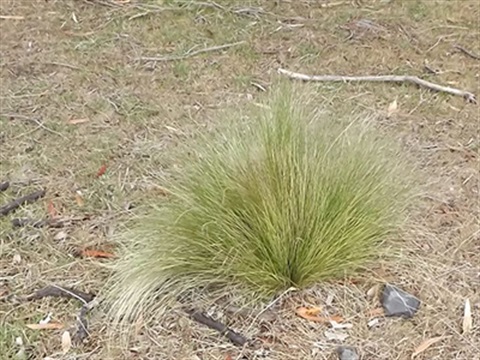Annual weed program

Weeds pose a serious threat to local agriculture, local economies and our native plants and animals. Council's Weed and Pest Animal Strategy 2014-2024 describe these challenges and our commitment to reducing the threat of weeds through our annual weed control program.
The program involves the control of weeds on Council-owned or managed roadsides and reserves. Our priorities when allocating our annual weed control budget are:
- protecting areas with significant or threatened flora and fauna
- meeting our legal obligations
- contributing to fire hazard reduction efforts
- supporting community-led projects and responding to community priorities
- protecting adjoining sites of high conservation value
- minimising harbour for pest animals
- achieving cost efficiencies.
On average, over 500 hectares of roadside is treated as a part of our annual roadside weed program in accordance with the above priorities. We generally prioritise treatment of noxious weeds listed under the Catchment and Land Protection Act 1994. Chilean needle grass is also considered a priority given the threat this weed poses to conservation and agricultural land. Our priorities for weed control may change as woody weed loads decrease across the shire as a result of effective management.
In some circumstances we treat environmental weeds which are not listed under the Catchment and Land Protection Act 1994 including non-indigenous native species which have the potential to be invasive such as Sallow Wattle and Cootamundra Wattle.
For more information on common weeds across the shire, Macedon Ranges, Mount Alexander, Mitchell Shire, Bendigo and Hepburn councils joined forces to produce a Weeds of Central Victoria Guide.
Agriculture Victoria has more information on identifying and the eradication of State prohibited weeds.
Weed programs
Nassella Program
Our Nassella Program actively treats Council managed roadsides and reserves with the aim of minimising any further spread of Serrated tussock and Chilean needle grass throughout the shire. This is done in conjunction with our roadside slashing program.
These pest plants have been classified as Weeds of National Significance (WONS) and can be found in various locations within the shire. It is important to treat known infestations of these noxious weeds as soon as they are identified. If you come across Serrated tussock or Chilean needle grass on a roadside or reserve, please contact us to report the infestation.
While we can treat these weeds for most of the year while the plants are active, it is best to treat them prior to setting seed over Spring and not to treat while the plants are inactive over Summer.
Serrated-Tussock.jpg(JPG, 149KB)
Roadside weed management responsibility
The Department of Energy, Environment & Climate Action (DEECA), VicRoads, Council and private landholders each have a responsibility to control weeds along roadsides. Responsibility is shared according to the type of road whether it be municipal roads, arterial roads or unmade/unopened roads.
Council-managed (municipal) roads
Council is responsible for the control of noxious weeds on Council-managed roadsides and fire access tracks throughout the shire. Common weed control situations under our management are given below.
Enquiries about weed control in these situations should be directed to the numbers provided.
|
Location
|
Sub-location
|
Responsible Department / Agency
|
|
Roadsides
|
Local roads in townships
Local roads outside townships
Declared main roads
|
Council - Park and Gardens unit
Council - Environment unit
VicRoads
|
|
Rail Reserves
|
Rail reserves
|
VicTrack or V/Line
|
|
Public Reserves
|
Council owned or managed Bushland Reserves
Recreation and sporting reserves
State Parks, Regional Parks, Flora Reserves & Crown Land
|
Council - Environment unit
Council - Parks and Gardens unit
Parks Victoria or DEECA
|
|
Waterways
|
Council owned or managed
Crown owned or managed
|
Council - Environment unit
Catchment Management Authorities
Water Authorities
|
Arterial roadsides
Regional Roads is responsible for the control of noxious weeds on arterial roadsides within the shire. Arterial roadsides under the management of VicRoads are listed below.
Contact the VicRoads Environment Officer on (03) 5434 5000 for more information about weed control along arterial roadsides.
|
Arterial Road Name (A-L)
|
Arterial Road Name (M-Z)
|
|
Avenue of Honour, Woodend
|
Melbourne Road, Gisborne
|
|
Blackforest Drive
|
Melbourne - Lancefield Road
|
|
Burton Avenue
|
Melton Road
|
|
Calder Freeway
|
Mt Macedon Tourist Road (from Blackforest Drive to Straws Lane)
|
|
Coach Road
|
Old Calder Highway
|
|
Daylesford - Malmsbury Road
|
Riddell Road
|
|
Edgecombe Road
|
Rochford Road
|
|
Gisborne - Kilmore Road
|
Romsey Road (from Woodend to Coach Road)
|
|
Heathcote - Kyneton Road
|
Saunders Road
|
|
Kilmore - Lancefield Road
|
South Rock Road (from Coach Road to Straws Lane)
|
|
Kyneton - Trentham Road
|
Station Road
|
|
Lancefield - Tooborac Road
|
Straws Lane (from South Rock Road to Mt Macedon Road)
|
|
Woodend - Tylden Road.
|
Unmade/unopened roads
Unmade/unopened roads may be maintained by private landholders. If classified as vacant crown land or crown land under license, weed control activities may be managed by an adjacent landowner.
DEECA can be contacted to answer any questions you may have about weed control in these situations on 136 186.
For more information on our weed treatment programs, call the Environment team on (03) 5422 0333 or email environment@mrsc.vic.gov.au